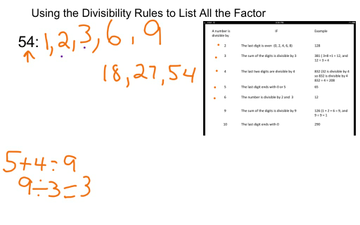A list of divisibility rules for 2, 3, 4, 5, 6, 7, 8, 9, 10 with examples. Divisibility Rules. We say that a number is divisible if it can be divided evenly with no. Printable Worksheets @ www.mathworksheets4kids.com Name: Divisibility Rule Sheet 1 Answer key 1) 3) 5) 7) 69,810 Is it divisible by 2? Is it divisible by 5? Is it divisible by 10?
Divisibility by 2
The number is divided by 2 when the last digit is even (0, 2, 4, 6, or 8).

2, 8, 16, 24, 66, 150 — divided by 2, as the last digits of the numbers is even;
3, 7, 19, 35, 77, 453 — not divided by 2, as the last digit of the number is odd.
Divisibility by 3
The number is divided by 3 when the sum of the digits is divided by 3.
75 — divided by 3, as 7+5=12, and the number 12 is divided by 3 (12:3=4);
471 — divided by 3, as 4+7+1=12, and the number 12 is divided by 3 (12:3=4);
532 — not divided by 3, as 5+3+2=10, and the number 10 is not divided by 3 (10:3=3
Divisibility by 4
The number is divided by 4 when the number formed by the last two digits is divisible by 4.

The two-digit number is divisible by 4 when twice the tens digit, plus the ones digit is divisible by 4.
4576 — divided by 4, as last two digits 76 divided by 4 (7·2+6=20, 20:4=5);
9634 — not divided by 4, as last two digits 34 not divided by 4 (3·2+4=10, 10:4=2
1.3 Divisibility Rulesmr. Mac's Page Key
Divisibility by 5
The number is divided by 5 when the last digit is 0 or 5.
375, 5680, 233575 — divided by 5, as the last digit of this numbers is 0 or 5;
9634, 452, 389753 — not divided by 5, as the last digit of this numbers isn't 0 or 5.
Divisibility by 6
The number is divided by 6 when it divided by 2 and 3.
462 — divided by 6, as it divided by 2 (last digits of the number is even) and divided by 3 (sum of the digits is divided by 3: 4+6+2=12, 12:3=4);
3456 — divided by 6, as it divided by 2 (last digits of the number is even) and divided by 3 (sum of the digits is divided by 3: 3+4+5+6=18, 18:3=6);
24642 — divided by 6, as it divided by 2 (last digits of the number is even) and divided by 3 (sum of the digits is divided by 3: 2+4+6+4+2=18, 18:3=6);
861 — not divided by 6, as it not divided by 2 (last digits of the number isn't even);
1.3 Divisibility Rulesmr. Mac's Page Shortcut
3458 — not divided by 6, as it divided by 3 (sum of the digits is not divided by 3: 3+4+5+8=20, 20:3=6
34681 — not divided by 6, as it divided by 2 (last digits of the number isn't even).
Divisibility by 9
The number is divided by 9 when the sum of the digits is divided by 9.
69759 — divided by 9, as sum of the digits is divided by 9 (6+9+7+5+9=36, 36:9=4);
34681 — not divided by 9, as sum of the digits is not divided by 9 (3+4+6+8+1=22, 22:9=2
Divisibility by 10
The number is divided by 10 when the last digit is 0.
460, 24000, 1245464570 — divided by 10, as the last digit of this numbers is 0;
234, 25048, 1230000003 — не делятся на 10, as the last digit of this numbers isn't 0.
Divisibility by 11
The number is divided by 11 if the sum of digits standing in even places is equal to the sum of digits standing in odd places or divided by 11.
242 — is divided by 11, as the sum of the numbers in odd positions S2n+1 = 2 + 2 = 4; sum of digits in even positions S2n = 4 and S2n+1 = S2n.
319 — is divided by 11, as the sum of the numbers in odd positions S2n+1 = 3 + 9 = 12; sum of digits in even positions S2n = 1, and their difference S2n+1 - S2n = 11 - divided by 11.
919380 — is divided by 11, as the sum of the numbers in odd positions S2n+1 = 9 + 9 + 8 = 26; sum of digits in even positions S2n = 1 + 3 + 0 = 4, and their difference S2n+1 - S2n = 22 - divided by 11.
2838 — is divided by 11, as the sum of the numbers in odd positions S2n+1 = 2 + 3 = 5; sum of digits in even positions S2n = 8+ 8 = 16, and their difference S2n - S2n+1 = 11 - divided by 11.
244 — is not divided by 11, as the sum of the numbers in odd positions S2n+1 = 2 + 4 = 6; sum of digits in even positions S2n = 4 and their difference S2n+1 - S2n = 2 - not divided by 11.
Add the comment
Cool Divisibility Rules
Special Thanks to: Patrick Burnett
You would probably learn the divisibility rules for 2, 3, 4, 5, 6, 8, and 9 in school. But what about the divisibility rule for 7? Well, the divisibility rule for 7 is quite simple, and quite interesting. All you have to do is take off the last digit of the number, multiply it by 2, and subtract that from the rest of the number. Here’s an example: Say you want to know if 469 is divisible by 7. If 469 is divisible by 7, then 46 – 2×9 must also be divisible by 7, and 46 – 18 = 28. Since 28 is divisible by 7, 469 is divisible by 7. That’s a quick way to check divisibility without having to do long division. Here’s another example: You want to know if 999999 is divisible by 7. If 999999 is divisible by 7, then 99999 – 2×9 = 99981 must be divisible by 7, and if 99981 is divisible by 7, then 9998 – 2×1 = 9996 must be divisible by 7, and if 9996 is divisible by 7, then 999 – 2×6 = 987 must be divisible by 7, and if 987 is divisible by 7, 98 – 2×7 = 84 must be divisible by 7, and we know that 84 is divisible by 7. Therefore, 999999 is divisible by 7.
1.3 Divisibility Rulesmr. Mac's Page Sheet
This trick can be generalized to different numbers. For the mathematical minded: If you want to prove if a number 10X + Y is divisible by P, where X is a positive integer, and Y is an integer from 0 to 9 inclusive, and find a K such that 10K + 1 is divisible by P, then X – KY must also be divisible by P.
In layman’s terms: You know that the divisibility rule for 7 involves subtracting 2 times the last digit from the other digits. A similar trick can be applied to other odd numbers. The reason why the last digit is multiplied by 2 is because 21 is the least multiple of 7 that ends in a 1. The divisibility rule for 13 is similar, but you would have to subtract 9 times the second digit from the other digits, as 91 is the least multiple of 13 ending in a 1, and for 17, you would multiply the last digit by 5, as 51 is the least multiple of 17 ending in a 1.
Are you suspicious? I don’t blame you, but see for yourself. Multiply 17 by a large number on a calculator, and try the trick on the large number. For example, you can try 83521. 8352 – 5×1 = 8347, 834 – 5×7 = 799, 79 – 9×5 = 34, and 34 is divisible by 17, so 83521 must also be divisible by 17.
You can do this with any odd ending in 1, 3, 7, or 9, as all odds ending in these numbers will eventually have a multiple ending in 1. Try to find the divisibility rule for 97. Scroll down to see the answer when you find it.

Answer: Subtract 29 times the second digit from the first.
